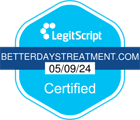But EMDR is one of the least understood. That’s a shame because it can be quite effective for certain types of people.
If you’re interested in learning more about EMDR, you’re in the right place. Keep reading to learn what it is, how it works, and why it might be able to help you overcome your toughest problems.
What is EMDR?
EMDR stands for Eye Movement Desensitization and Reprocessing. It’s a technique that uses your eye movements to help you process trauma and other tough emotions in less time.
That might sound a bit out there, but there’s lots of research that confirms this works. It’s certainly worth trying if you’re interested in speeding up the recovery timeline or you’ve had difficulty making progress with traditional methods of care.
What can EMDR help with?
EMDR is primarily used to help people recover from mental health issues. It’s grown popular as a style of treatment for PTSD and related symptoms. But it can also be an effective way to deal with mental health problems like:
- Anxiety
- Depression
- Panic disorders
If you’re experiencing some of these problems, then completing an EMDR regiment could help you overcome them faster than you would with traditional therapy alone.
Of course, there are no guarantees of that. But the research does indicate that the average person should expect a speedier recovery timeline when they use EMDR.
What are EMDR sessions like?
EMDR sessions don’t use a ton of scary or overwhelming machines. They’re actually very simple.
You’ll go into a room with an EMDR therapist, just like you would go into a normal therapist’s office. Once there, the therapist will ask you to hold different aspects of the trauma in your mind while following their moving hand with your eyes.
This process stimulates internal associations and deep memories about the experiences that are causing your problems. That may prompt you to begin processing those memories in healthier ways on a much faster timeline than what would be possible through therapy alone.
The average EMDR session takes between 60 and 90 minutes to complete. Most people visit their EMDR therapist one or two times per week. And it usually takes 6-12 sessions to complete the treatment program.
That means you should expect your EMDR course of care to take anywhere from 3 to 12 weeks to finish.
Getting started with EMDR is easy when you contact Better Days
Are you interested in learning more about EMDR? Or maybe you’re ready to sign up for treatment sessions now. Either way, the next step is reaching out to Better Days.
Our specialists are standing by to answer your questions, verify your insurance, and get you started with a personalized care plan. If you’re located in the Southern California area, Anaheim, we can get you started with EMDR as soon as possible so that you can begin making progress as soon as possible as well.
Get in touch with us today to learn more about how we can help.
